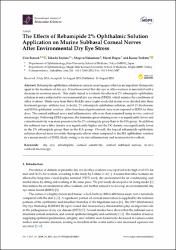The Effects of Rebamipide 2% Ophthalmic Solution Application on Murine Subbasal Corneal Nerves After Environmental Dry Eye Stress
Abstract
Rebamipide ophthalmic solution is a mucin secretagogue which is an important therapeutic agent in the treatment of dry eye. It has been noted that dry eye in office workers is associated with a decrease in secretory mucin. This study aimed to evaluate the effects of 2% rebamipide ophthalmic solution in mice subjected to environmental dry eye stress (EDES), which mimics the conditions of office workers. Thirty eyes from thirty BALB/c mice (eight-week-old males) were divided into three treatment groups: artificial tear (vehicle), 2% rebamipide ophthalmic solution, and 0.1% hyaluronic acid (HA) ophthalmic solution. After four days of pretreatment, mice were exposed to EDES for three days. The corneal subbasal nerve and inflammatory cells were then examined using in vivo confocal microscopy. Following EDES exposure, the lissamine green staining score was significantly lower and corneal sensitivity was more preserved in the 2% rebamipide group than in the HA group. In addition, the subbasal nerve fiber density was significantly higher and the DC density was significantly lower in the 2% rebamipide group than in the HA group. Overall, the topical rebamipide ophthalmic solution showed more favorable therapeutic effects when compared to the HA ophthalmic solution in a mouse model of EDES, likely owing to its anti-inflammatory and neuroprotective effects.


















